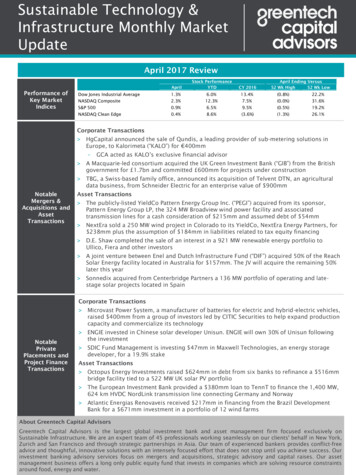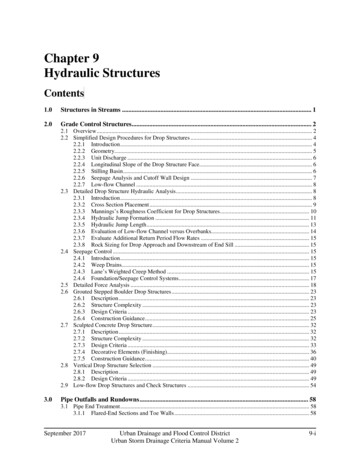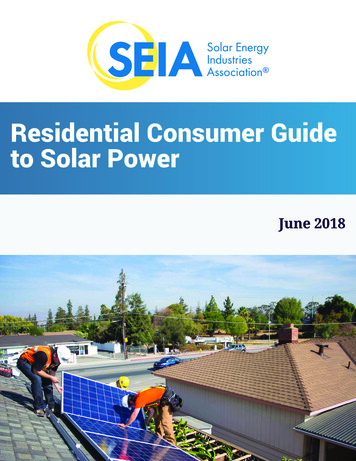
Transcription
Presenting a live 90-minute webinar with interactive Q&ASolar Financing Tax Equity Structures:Sale-Leasebacks, Inverted Leasesand Partnership FlipsChoosing the Right Structure, Weighing Advantages and Drawbacks of Various StructuresTHURSDAY, AUGUST 13, 20151pm Eastern 12pm Central 11am Mountain 10am PacificToday’s faculty features:Keith Martin, Partner, Chadbourne & Parke, Washington, D.C.Jorge Medina, Assistant General Counsel, SolarCity, San Mateo, Calif.The audio portion of the conference may be accessed via the telephone or by using your computer'sspeakers. Please refer to the instructions emailed to registrants for additional information. If youhave any questions, please contact Customer Service at 1-800-926-7926 ext. 10.
Tips for Optimal QualityFOR LIVE EVENT ONLYSound QualityIf you are listening via your computer speakers, please note that the qualityof your sound will vary depending on the speed and quality of your internetconnection.If the sound quality is not satisfactory, you may listen via the phone: dial1-866-328-9525 and enter your PIN when prompted. Otherwise, pleasesend us a chat or e-mail sound@straffordpub.com immediately so we can addressthe problem.If you dialed in and have any difficulties during the call, press *0 for assistance.Viewing QualityTo maximize your screen, press the F11 key on your keyboard. To exit full screen,press the F11 key again.
Continuing Education CreditsFOR LIVE EVENT ONLYIn order for us to process your continuing education credit, you must confirm yourparticipation in this webinar by completing and submitting the AttendanceAffirmation/Evaluation after the webinar.A link to the Attendance Affirmation/Evaluation will be in the thank you emailthat you will receive immediately following the program.For additional information about CLE credit processing call us at 1-800-926-7926ext. 35.
Solar Tax Equity StructuresKeith Martinkmartin@chadbourne.comJorge Medinajmedina@solarcity.comNew York Washington Los Angeles Mexico City São Paulo Moscow Warsaw Istanbul Dubai Johannesburg London
The tax benefits on solar projects amount toroughly 56 per dollar of capital cost.Solar tax equity deal volume was 4.5 billion in2014. Wind and solar together were 10.1billion. Deal volume is expected to be higher in2015.spillover5New York Washington Los Angeles Mexico City São Paulo Moscow Warsaw Istanbul Dubai Johannesburg London
Solar projects must be in service by December2016 to qualify for a 30% investment taxcredit. The credit drops to 10% after 2016. Thereis a reasonable chance that Congress will convertthe 2016 deadline into a deadline merely to startconstruction, but it may not happen this year.tax extenders6New York Washington Los Angeles Mexico City São Paulo Moscow Warsaw Istanbul Dubai Johannesburg London
We see at least 32 tax equity investors currentlyin the market.JP MorganBank of AmericaGEMUFGWells FargoGoogleState StreetMetLifeUS BankGoldman SachsCapital OneBarclaysRBCMorgan StanleySumitomoToyota TsushoBank of New YorkCredit SuisseKey BankBanco SantanderCitigroupLiberty MediaPNC BankBNP ParibasNorthwestern MutualBerkshire HathawayRegions BankPatagoniaDominionSouth Jersey IndustriesSettlement InsuranceMacquarie7New York Washington Los Angeles Mexico City São Paulo Moscow Warsaw Istanbul Dubai Johannesburg London
There are at least another nine tax equityinvestors who have done some deals, but do notappear to be active currently.National Bank of ArizonaWashington GasHondaUlupono InitiativeCIRIStandard CharteredPG&ESempraOne West8New York Washington Los Angeles Mexico City São Paulo Moscow Warsaw Istanbul Dubai Johannesburg London
Another 12 companies are on lists of potential taxequity investors.Silicon Valley BankAllianzCITBBVASamsungLG CorporationBB&TFifth ThirdIntelNew York LifeMicrosoftFacebookStarbucks9New York Washington Los Angeles Mexico City São Paulo Moscow Warsaw Istanbul Dubai Johannesburg London
Tax equity yields in the last six months have beentrending down, although tax equity investors arerecovering some of the decline in fees and areoften pricing to a second yield 50-bps higher atyear 20. Utility-scale solar yields are 7.25% to 8%unleveraged for the least risky deals involving themost experienced sponsors. Rooftop solar forbrand-name developers is a little below 9%. 1.10 to 1.3210New York Washington Los Angeles Mexico City São Paulo Moscow Warsaw Istanbul Dubai Johannesburg London
Leverage can increase yield by at least 500bps. There is little debt ahead of tax equity in thecapital structure. The market consensus onforbearance has largely collapsed.11New York Washington Los Angeles Mexico City São Paulo Moscow Warsaw Istanbul Dubai Johannesburg London
There are three main structures with twosignificant variations. The three are partnershipflips, inverted leases and sale-leasebacks.12New York Washington Los Angeles Mexico City São Paulo Moscow Warsaw Istanbul Dubai Johannesburg London
A partnership flip is a simple concept. A sponsorbrings in a tax equity investor as a partner to owna renewable energy project together. Thepartnership allocates taxable income and loss99% to the tax equity investor until the investorreaches a target yield, after which its share ofincome and loss drops to 5% and the sponsorhas an option to buy the investor's interest. Cashmay be distributed in a different ratio before theflip.cash droughtyield coscall option13New York Washington Los Angeles Mexico City São Paulo Moscow Warsaw Istanbul Dubai Johannesburg London
Basic Yield FlipFMV Call OptionSponsor1/95SponsorAffiliateTax Equity Investor99/5UtilityO&M ContractPPAProject14New York Washington Los Angeles Mexico City São Paulo Moscow Warsaw Istanbul Dubai Johannesburg London
The IRS issued guidelines for partnership fliptransactions in 2007. The guidelines provide a"safe harbor" for transactions that conform tothem. Most do. The IRS said recently that theguidelines were written with wind projects inmind and are not a safe harbor for solartransactions.central tension15New York Washington Los Angeles Mexico City São Paulo Moscow Warsaw Istanbul Dubai Johannesburg London
There are two main variations in flipstructures. In addition to the yield-based flip,there is also a fixed-flip structure that is offeredby a small subset of tax equity investors and thatleaves as much cash as possible for the sponsor.2% preferred cash distributionsput and call16New York Washington Los Angeles Mexico City São Paulo Moscow Warsaw Istanbul Dubai Johannesburg London
Fixed FlipPut and Call OptionTax Equity Investor99/5 2% preferred yO&M ContractPPAProject17New York Washington Los Angeles Mexico City São Paulo Moscow Warsaw Istanbul Dubai Johannesburg London
The sponsor is responsible for day-to-daymanagement of the project. TEI consent isrequired for a list of "major decisions."18New York Washington Los Angeles Mexico City São Paulo Moscow Warsaw Istanbul Dubai Johannesburg London
The TEI may invest by buying an interest in thepartnership from the sponsor ("purchase model")or by making capital contributions to thepartnership ("contribution model"). Thepurchase model may give the TEI a larger basisstep up for calculating tax benefits.19New York Washington Los Angeles Mexico City São Paulo Moscow Warsaw Istanbul Dubai Johannesburg London
Almost all partnership flip transactions have"absorption" issues. Each partner has a "capitalaccount" and "outside basis" that are two ways ofmeasuring what the partner put into the deal andwhat it is allowed to take out in tax benefits. MostTEIs run out of capital account before they areable to absorb 99% of the depreciation.DRO20New York Washington Los Angeles Mexico City São Paulo Moscow Warsaw Istanbul Dubai Johannesburg London
Yield-based flips in the solar market price toreach yield in six to eight years. Fixed-flip dealsflip at five to six years. Investors want at least a2% pre-tax yield.21New York Washington Los Angeles Mexico City São Paulo Moscow Warsaw Istanbul Dubai Johannesburg London
In a sale-leaseback, the solar company sells theproject to a tax equity investor and leases itback. Unlike a flip where the TEI gets at most99% of the tax benefits, all the tax benefits aretransferred to the TEI without complicatedpartnership accounting. The TEI calculates themon the fair market value purchase price it pays forthe project. The lessee has a gain on sale to theextent the project is worth more than it cost tobuild.22New York Washington Los Angeles Mexico City São Paulo Moscow Warsaw Istanbul Dubai Johannesburg London
Sale-LeasebackTax Equity t23New York Washington Los Angeles Mexico City São Paulo Moscow Warsaw Istanbul Dubai Johannesburg London
A flip raises 40% to 70% of the project value. Asale-leaseback raises 100% in theory. In practice,the sponsor is usually required to repay part ofthe purchase price as prepaid rent.section 467 loan24New York Washington Los Angeles Mexico City São Paulo Moscow Warsaw Istanbul Dubai Johannesburg London
The IRS has guidelines for leveraged leaseswhere the lessor raises part of the purchase priceby borrowing from a bank. These guidelines limitthe term of the leaseback to 80% of the expectedlife and value of the project. If the lessee wants tokeep the project at the end of the lease, the lesseemust repurchase it. Any lessee purchase optioncannot be at a price that makes the optionreasonably likely to be exercised.economic compulsionequity investment25New York Washington Los Angeles Mexico City São Paulo Moscow Warsaw Istanbul Dubai Johannesburg London
Sale-leasebacks remain common in the C&I andutility-scale solar markets. They are uncommonin the rooftop market, where the deals are splitcurrently between partnership flips and invertedleases. Rooftop companies dislike saleleasebacks because they feel the TEIs pay toolittle at inception for the residual value.26New York Washington Los Angeles Mexico City São Paulo Moscow Warsaw Istanbul Dubai Johannesburg London
Inverted leases are used mainly in the rooftopmarket. Think of a yo-yo. The solar companyassigns customer agreements and leases rooftopsolar systems in tranches to a tax equity investorwho collects the customer revenue and paysmost of it to the solar company as rent. The solarcompany passes through the investment credit tothe tax equity investor. It keeps thedepreciation. The solar company takes the assetback at the end of the lease.27New York Washington Los Angeles Mexico City São Paulo Moscow Warsaw Istanbul Dubai Johannesburg London
Basic Inverted LeaseSponsorAssignment ofcustomer AgreementLeaseTax EquityInvestorSponsorO&MAgreementSolar PPAorLeaseCustomers28New York Washington Los Angeles Mexico City São Paulo Moscow Warsaw Istanbul Dubai Johannesburg London
Sponsors like inverted leases because they getthe asset back without having to pay for it, andthe investment credit is calculated on the fairmarket value of the solar equipment rather thanits cost. Unlike a sale-leaseback, the step up inasset basis does not come at a cost to thesponsor of a tax on a commensurate gain.29New York Washington Los Angeles Mexico City São Paulo Moscow Warsaw Istanbul Dubai Johannesburg London
There are no IRS guidelines for inverted leases,unlike the other two structures. However, thestructure is common in historic tax credit deals,and the IRS acknowledged it in guidelines in early2014 to unfreeze the historic tax credit marketafter a US appeals struck down an aggressiveform of the structure in a case called HistoricBoardwalk.30New York Washington Los Angeles Mexico City São Paulo Moscow Warsaw Istanbul Dubai Johannesburg London
The TEI must have upside potential and downsiderisk to be considered a real lessee. Some taxcounsel like to see a "merchant tail.” Othersfocus on the amount of prepaid rent paid by thelessee and want to see at least a 20% rentprepayment.big four31New York Washington Los Angeles Mexico City São Paulo Moscow Warsaw Istanbul Dubai Johannesburg London
Inverted leases raise 20% to 45% of project value.The central challenge in inverted leases is howthe capital raised by the structure moves from theTEI to the sponsor. In the conservative form, itmoves as prepaid rent. In an overlappingownership structure, the lessor makes a capitalcontribution to the lessor, and the lessee owns49% of the lessor.32New York Washington Los Angeles Mexico City São Paulo Moscow Warsaw Istanbul Dubai Johannesburg London
Overlapping OwnershipInverted LeaseSponsor51%Lessee49%LeaseFMV Call OptionSponsor1/99Tax EquityInvestor99/5 withdrawal right33New York Washington Los Angeles Mexico City São Paulo Moscow Warsaw Istanbul Dubai Johannesburg London
The three structures vary in terms of the amountof capital raised, risk allocation and the timing ofwhen the TEI must invest. The sponsor must turnto other sources of capital (debt and equity) toraise the rest of the project cost.34New York Washington Los Angeles Mexico City São Paulo Moscow Warsaw Istanbul Dubai Johannesburg London
Focusing on risks, in a sale-leaseback, thesponsor has a hell-or-high-water obligation to payrent and must indemnify the TEI for loss of taxbenefits and any acceleration of rental incomedue to a lessee breach of a representation orcovenant. In a flip, the TEI's return turns on howwell the project performs. The TEI's protection isit sits on the project at a 99% level until it reachesa target yield.inverted lease35New York Washington Los Angeles Mexico City São Paulo Moscow Warsaw Istanbul Dubai Johannesburg London
The principal business risks in any transactionare weather, technology and offtaker credit.36New York Washington Los Angeles Mexico City São Paulo Moscow Warsaw Istanbul Dubai Johannesburg London
Basis risk tends to be borne by the sponsor,although this has been true only since 2010.Tax risks about which the sponsor has specialinsight are borne by the sponsor. Tax risks intowhich both the sponsor and TEI have equalinsight are borne by the TEI. Risks over whichneither has special insight are jump balls.fixed tax assumptions37New York Washington Los Angeles Mexico City São Paulo Moscow Warsaw Istanbul Dubai Johannesburg London
Turning to timing, the TEI must be a partner in aflip deal before the project is placed in service.In some transactions, the TEI makes enough of itsinvestment before the project is put in service tobe a partner and contributes the rest after finalcompletion. Inverted leases must be done beforeassets go into service. A sale-leaseback can bedone up to three months after the asset is put inservice.unwind risk38New York Washington Los Angeles Mexico City São Paulo Moscow Warsaw Istanbul Dubai Johannesburg London
The investment credit vests over five years. Theunvested credits will be recaptured if the assetsare disposed of or a partner disposes of hisinterest or there is more than a one-thirdreduction in his share of partnership profitsduring the first five years.stop loss shiftlock-in effect39New York Washington Los Angeles Mexico City São Paulo Moscow Warsaw Istanbul Dubai Johannesburg London
The asset basis must be reduced by half theinvestment credit. In an inverted lease, since thelessee claims the credit but does not claimdepreciation, it must report 50% of the credit asincome ratably over five years. If the lessee is apartnership, some TEIs use the income toincrease "outside basis" and then claim a losswhen they withdraw from the partnership.An IRS notice is expected on this subject.40New York Washington Los Angeles Mexico City São Paulo Moscow Warsaw Istanbul Dubai Johannesburg London
Some recurring issues in deals are the following:inappropriate TEIschange-in-law riskbasis riskaffiliate salesoutput forecastsmerchant riskcash sweepsOCCbook lossVolcker rule41New York Washington Los Angeles Mexico City São Paulo Moscow Warsaw Istanbul Dubai Johannesburg London
Solar Tax Equity StructuresKeith Martinkmartin@chadbourne.comJorge Medinajmedina@solarcity.comNew York Washington Los Angeles Mexico City São Paulo Moscow Warsaw Istanbul Dubai Johannesburg London
In a sale-leaseback, the solar company sells the project to a tax equity investor and leases it back. Unlike a flip where the TEI gets at most 99% of the tax benefits, all the tax benefits are transferred to the TEI without complicated partnership accounting. The TEI calculates them on the fair market value purchase price it pays for the project.










